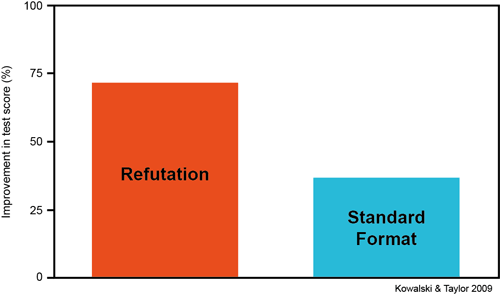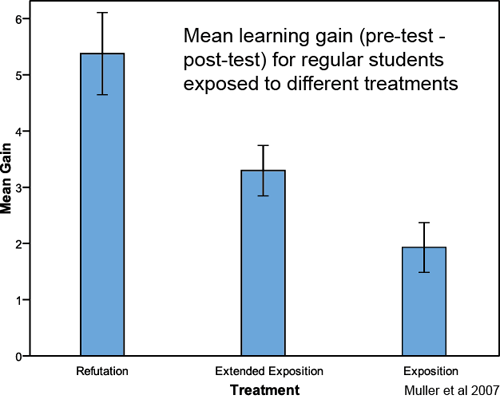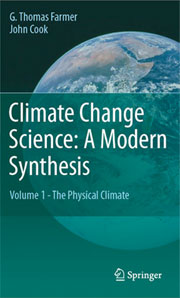The educational opportunities in addressing misinformation in the classroom
Posted on 8 March 2013 by John Cook
An interesting discussion arose in Tom Farmer’s latest blog post about our textbook Climate Change Science: A Modern Synthesis. One of the commenters questioned whether certain sections should have been included in the textbook. The two chapters he referred to were Chapter 23: Understanding Climate Change Denial and Chapter 24: Rebuttals to Climate Myths. I would argue that not only are such chapters appropriate, they are essential to a comprehensive climate education. In fact, I would go further. Addressing misinformation in the classroom is not just a necessary evil – it’s actually an opportunity that educators should be embracing.
Firstly, it’s important to understand that education isn’t just a matter of downloading new information into student’s heads. An important aspect is correcting misperceptions. Jonathan Osborne sums it up nicely when he says "Comprehending why ideas are wrong matters as much as understanding why some ideas may be right." Another famous educator provides an even pithier quote on the importance of correcting misperceptions.
What is the best way for teachers to dispel misconceptions? Is it enough to simply teach students the facts? It turns out no. A study conducted with 1st year psychology students found that lectures explicitly refuting misconceptions were twice as effective as the standard lecture format in reducing misconceptions. Teachers need to directly challenge false ideas to provoke students into examining their preconceptions.

Similarly, a study of physics students found that directly debunking physics misconceptions was considerably more effective than exposition style lectures that merely explained the correct physics. What's interesting about this particular research was students were more confident about their physics knowledge after exposition lectures but scored worse. After a refutational lecture, they were less confident about their knowledge but scored better. This shows that misconceptions have two negative influences. They interfere with correct information and they also instill a false sense of knowing. Debunking teaches science but it also teaches a little humility.

So addressing misinformation head-on is the most effective way of reducing students’ misperceptions. But there is also an exciting educational opportunity in debunking myths. When you debunk a myth, you create a gap in people’s understanding of the world. If you don't fill that gap, the myth will come back to fill the hole. You fill the gap by creating an alternative explanation. The structure of an effective debunking is to create a gap, then fill the gap.

There is a highly recommended book on communication by the Heath brothers, Made to Stick. The authors identify one of the traits of “sticky” ideas that are compelling and memorable. A compelling message arouses people's curiosity then satisfies their curiosity. The way to do this is by creating gaps in people's knowledge then filling those gaps. Sound familiar? The very nature of debunking myths lends itself to creating engaging, "sticky" material that raises questions in people's minds then answers the questions.
 This is why college professors such as Daniel Bedford from Weber State University, Utah, are addressing misinformation in their classrooms as a way of teaching critical thought and the nature of science. Given that more lecturers and educators are recognising the importance of addressing misinformation, Tom and I decided to include the most detailed treatment of climate misinformation and the phenomenon of climate change denial in a climate textbook (to our knowledge). Chapter 23: Understanding Climate Change Denial goes into detail on the characteristics of denial, what is driving climate denial (essential to understanding the controversy) and how to respond to misinformation. Chapter 24: Rebuttals to Climate Myths features concise rebuttals to the most popular climate myths, with each rebuttal adhering to the structure recommended in the Debunking Handbook. If any lecturers, professors or educators are interested in receiving a sample copy of the chapter Understanding Climate Change Denial, feel free to contact me.
This is why college professors such as Daniel Bedford from Weber State University, Utah, are addressing misinformation in their classrooms as a way of teaching critical thought and the nature of science. Given that more lecturers and educators are recognising the importance of addressing misinformation, Tom and I decided to include the most detailed treatment of climate misinformation and the phenomenon of climate change denial in a climate textbook (to our knowledge). Chapter 23: Understanding Climate Change Denial goes into detail on the characteristics of denial, what is driving climate denial (essential to understanding the controversy) and how to respond to misinformation. Chapter 24: Rebuttals to Climate Myths features concise rebuttals to the most popular climate myths, with each rebuttal adhering to the structure recommended in the Debunking Handbook. If any lecturers, professors or educators are interested in receiving a sample copy of the chapter Understanding Climate Change Denial, feel free to contact me.































 Arguments
Arguments






























This is a really good post John. Denialism (misinformation and disinformation) must be attacked on all fronts, and as you mentioned, a textbook should touch on negative as well as the positive, especially in a science textbook about what some people consider a "controversial" subject. To the informed, climate change and global warming are not controversial. It is most likely the uninformed (like most entering college freshmen) who see both sides of the "controversy." An introductory science textbook that's intended as a survey of the science should introduce students to all aspects of the science, even the negative ones. That's why, in my experience, students gain a much better understnding of scientific concepts when they see the errors presented by the negative deniers of the facts. This is basically why we included the two chapters in our new textbook, "Climate Change Science: A Modern Synthesis."
I am all for this if there is some discussion made on the reason(s) why one theory is wrong and another is correct. But it seems there is little real discussion.
I do not believe all the present theory as to the causes of climate change are being considered. I strongly believe that carbon dioxide is being said to be the prime reason for change when it is only a real small factor.
I think that water vapor is being ignored because if that is the main cause then there are a lot of reprocussions to that. The vast areas of the usa which are routinely irrigated and sprinkler use to water crops are contributing to a large amount of the change but seem to be completely ignored. I can understand why since it would mean no more golf courses and manicured lawns in the middle of deserts like Nevada.
There are statistics showing that the auquifer under the middle of the usa dropped 150 feet in one decade alone. I am not sure what crisis level that has reached so far but I am sure it is not getting any better.
It seems also that putting thousands of tons of water vapor into the atmosphere at 38,000ft seems to be completely ignored and minimized when it is considered. To my knowledge, I seem to recall that almost all of our weather occurs in the lower atmosphere normally not higher than about 20,000 ft. Jet airplanes produce 5 pounds of water vapor per pound of fuel burned and they burn a whole lot of it. There are approximately 4000 planes in the air over the usa at any given time but it less than it was before 9/11. I am not sure about their fuel use but I am sure it is not insignificant.
So, has anyone ever considered the affect of introducing huge amounts of water vapor into the atmosphere where it never used to occur before these jet aircraft began flying there? I hear noone in the gloabal warming crowd even considering how this might be causing a lot of what they are blaming co2 for doing.
Now this does not even consider the affect that evaporating water will have on the transfer of energy in great quanities into the lower atmosphere from where the solar energy which vaporizes it used to simply heat up sand and rocks on the ground. This large transfer of energy into the atmosphere could solely be the reason for a lot of our climate change and the change in amount and intensity of storms.
At least give this some consideration. I am not the only scientist to say this and there are some on the internet who have put together some interesting facts and figures about it. It is easy to find if you look.
[DB] "At least give this some consideration" To be kind, this already has been looked into and discussed by scientists.
As a condensible greenhouse gas, water vapor is a feedback to CO2 and by itself cannot make long-term changes in global temperatures. Please take that discussion to this thread if you wish to continue pursuing that.
For a discussion of stratospheric water vapor and contrail forcings, see this thread.
[KC] See also IPCC AR4 chapter 2.6.2. The literature is very extensive, google scholar can find lots for you with the search contrail forcing. That includes some research on the 9/11 no-fly - an initial paper suggested a significant impact, subsequent results were much more equivocal. There are also results from WWII bomber squadrons which are useful.
Water vapour has not been ignored. Scientists know that it is our planet's most abundant greenhouse gas, and that it plays an important role in global warming. In fact, the atmospheric water content over the oceans has been measured to be increasing by 0.41 kg per square meter every ten years since 1998.
But water vapour doesn't just go up and stay up—excess water in the atmosphere falls to Earth as rain or snow within a week. The amount of water the atmosphere can hold is almost purely a function of temperature. So what caused the warming that's causing increased evaporation?
CO2, the gas responsible for 25% of the greenhouse effect. CO2 emissions have soared in recent history, and unlike water vapour, it stays in the atmosphere for 50 to 200 years. We've only been directly observing CO2 levels in the atmosphere and global temperatures for a short period of time, but geological evidence extends these records hundreds of thousands of years into the past, and what we see are that the two main controls on Earth's thermostat are 1) the output of the Sun, and 2) CO2 levels in the atmosphere. Water vapour is the largest amplifier of the effect of CO2, but there's a large body of research establishing CO2 as the main cause.
Sorry, this is OT.
A new paper has been published in Science
A Reconstruction of Regional and Global Temperature for the Past 11,300 Years
Unfortunately, it is paywalled. Do you think, you could write something about it on SkS?
First of all, I know that you are correct about water vapor falling out of the air in lower altitudes, but what is the proof it falls out of the air when injected into it at such high altitudes as 35,000 to 39,000 ft? If you know elementary physics you know that water vapor is lighter than air and that hot humid air is markedly lighter than dry cool air. I also know that water vapor at that altitude should have a much greater affect on overall sunlight getting through to the ground. It would act like a grid in a vacuum tube to control energy getting to the surface of our planet. Dont dismiss the fact that jet airplanes also put that water vapor into the air at a very high temperature which represents a lot of energy too.
I subject to you that in the far distant past when many say that our planet was mostly covered in forests that it was most likely hot and humid over the whole globe. I would contend that it was caused by the enormous amount of water vapor in the air and that most of the carbon would have been tied up in vegetation due to photosynthesis. Where else did all those huge coal and oil deposits come from otherwise? I think your own data on co2 confirms this to be the case. So if there was not a lot of co2 in the atmosphere when all that coal and oil was being formed, what caused all the water vapor to be in the air?
I have seen graphs showing past temperature variations plotted against time where it was also shown the estimated amount of co2 in the air based on the amounts found in ice deposits. In those plots it was shown that the rise in co2 followed the warming trend and did not preceed it.
Now as to what is making the water evaporate. It does not take any higher rise in temperature to cause water spread around on the ground to evaporate. Nor the water in swimming pools and lakes etc. MAN has caused this massive change in where and how water is evaporating. Or do you want to totally dismiss the tremendous amounts which evaporate each year now to man and not to nature doing it. I think the study done showed it to be on the order of 2 billion tons of water from irrigation and sprinkling etc. This causes a massive shift in energy from where the energy would normally stay in heating rocks and sand to putting that energy into the atmosphere. The energy in those hot rocks and sand does not affect our weather to any great extent as the energy is confined to low altitudes due to the insualting qualities of air. However when you put that energy into the air higher up where weather patterns occur it can have a vast influence on things. I contend that is the major reason for our shifts in weather patterns.
Condemnnig this evaporation steps on a lot more toes than blaming co2. Farmers who irrigate would have to stop it. Vast desert areas we presently turn into greem places would have to go back to being deserts. I could go on, but you get the idea. Also we would have to curtail high altitude jet flights.
Btw the WWII bombers were mostly restricted to lower altitudes until near the end of the war. And also jet engines burn a whole lot more of hygrocarbons than those gasoline engines used on those bombers.
[KC] The appropriate thread for discussion of the role of water vapour is here. Please take a moment to review the comment policy, which exists to enable serious and focused scientific discussion. Further comments on the specific role of water vapour are clearly more appropriate to that thread (where contributors including myself will be happy to engage with your hypothesis) but will therefore be deleted from this one.
I think the argument would have been more effective if in Chapter 23 it was emphasized that consenses between scientists does not make something true. A few examples of a clear and obvious nature like the belief in a flat earth would help. The next point would be to say that good science goes with the evidence so far known and draws the most logical conclusions from this information. However, true science is willing to modify or even completely throw out a theory if the evidence to the contraty is compelling. Science must never become a religion as happens all too often with scientists. An exposition of Occams Razor might finish this section. The same argument would be relevant with regard to teaching creationism instead of Darwinian evolution.
http://mtkass.blogspot.co.nz/2007/08/intelligent-design-let-it-be-taught.html
william,
While "consensus between scientists does not make something true" is correct, any statement to that effect should be combined with the observation that you're overwhelmingly more likely to be right if you accept what almost all experts on the subject believe than if you decide to believe the opposite. :-) There are very few true Galileos throughout history and an awful lot of cracks.
"They said Galileo was a fool. They said Einstein was a fool. They said the Wright Brothers were fools. What you've got to remember, however, is that they also said that about a lot of fools."
I think that the true value of teaching in this way is that education is not so much about implanting facts or displacing myths, but rather about teaching a truly skeptical scientific way of thinking and researching things for yourself. I learned a lot of "facts' about mineralogy, palaeontology and stratigraphy as a geology undergraduate, but they disappeared from my brain shortly after the final exams. What stuck was what I learned about how to think, gained largely from interacting and arguing with professors and graduate students in labs and on field trips, and from doing my own reading outside the curriculum.
The head of the department at the time (the early 1970's) was one of the last of the plate tectonics deniers and it was doing my own reading and questioning on that subject that was more fruitful than attending hours of lectures on the evolution of trilobites. There is a lot to be said for teaching the controversy, at university level, anyway.
martin@4
The appropriate thread for your news is here where I have also commented. Like you I also hope SkS will comment on it sometimes.
Electroken presents us with a perfect example of why the myths must be debunked along with teaching the science. Every point he raises has been considered in far more detail than he has himself pursued, and yet he starts with the assumption that scientists shave missed all of his (rather obvious) points, rather than the reality, which is that they have considered and studied them in far, far more detail than electroken has. But of course, rather than take the hard course of thoroughly researching the topics and recognizing that scientists have been there, done that, and moved on, he charges full-steam-ahead with his assumption, applying whatever simplistic logic and anecdotal evidence comes easily to mind, and sees this self-visualized model as a reason to distrust the scientists and the textbooks.
So he has made the point of the original post rather emphatically. People must be taught about the untruths as much as the truths, or they will find ways to tie themselves into knots of denial -- without even recognizing the cognitive bias that has helped to nudge them astray.
Have to say it, I exploded laughing at the Yoda link
To put John's recommendation of refuting a myth into practice; electroken@2 wrote "Jet airplanes produce 5 pounds of water vapor per pound of fuel burned and they burn a whole lot of it"
Well, it seems the science begs to differ. The FAA (2005) wrote that "Aircraft engine emissions are roughly composed of about 70 percent CO2, a little less than 30 percent H2O, and less than 1 percent each of NOx, CO, SOx, VOC, particulates, and other trace components including HAPs."
And I see that comment didn't work at all. Well I know for next time to just use the Source section (walks away in shame)
Son of Krypton ,EPA lists Jet Fuel at 20.89 Lbs of CO2 per gallon.
http://www.epa.gov/cpd/pdf/brochure.pdf
A gallon of jet fuel weighs about 6.8 pounds. So a pound of jet fuel produces about 3.1 Lbs of CO2. Jet engines emit about 2.3 times as much CO2 than H2O, which would put the ratio at approximately 1.3 Lb of water per Lb of jet fuel. Feel free to double check, there are multiple sources where this is examined. I don't know where Elektroken got his 5:1 figure.
FAA figures.
Taking dodecane (C12H26) as a typical hydrocarbon in kerosene, then:
2 x C12H26 + 37x O2 → 24 x CO2 + 26 x H2O
Substituting in atomic masses, we get:
2 * (12 * 12 + 26 * 1) + 37 * (16 * 2) = 24 * (12 + 2 * 16) + 26 * (2 * 1 + 16)
or 340 + 1184 = 1056 + 468.
So, the mas of water produced is 1.37 times the mass of fuel burned. The mass of CO2 produced is 3.1 times the mass of fuel burned. And the mass of CO2 is 69% of the total emissions by mass, with H2O constituting 31%.
Of course, not all kerosene is dodecane, and in most circumstances it will not combust perfectly, so these are just ball park figures, but certainly confirm Sof of Krypton and Phillippe Chantreau.
Of course, this is just having fun around the edges. The true rebutal of elecktron was given by KC in moderator box. Just because elektron was unfamiliar with the literature did not give him the right to assume that scientists had not investigated the effect he just thought of in great detail.
Thanks for doing the leg work Tom. My figures closely match your results, not surprisingly as they came from reliable sources. As always when physical reality is considered, there is a right answer and it's not all a matter of opinion. Because combustion is not perfect and there is more than just C and H in Jet fuel, the actual ratios are about 70% CO2, a little less than 30 % water and less than 1% SO, NO, CO and others. The links above have details. Elektroken was way off.